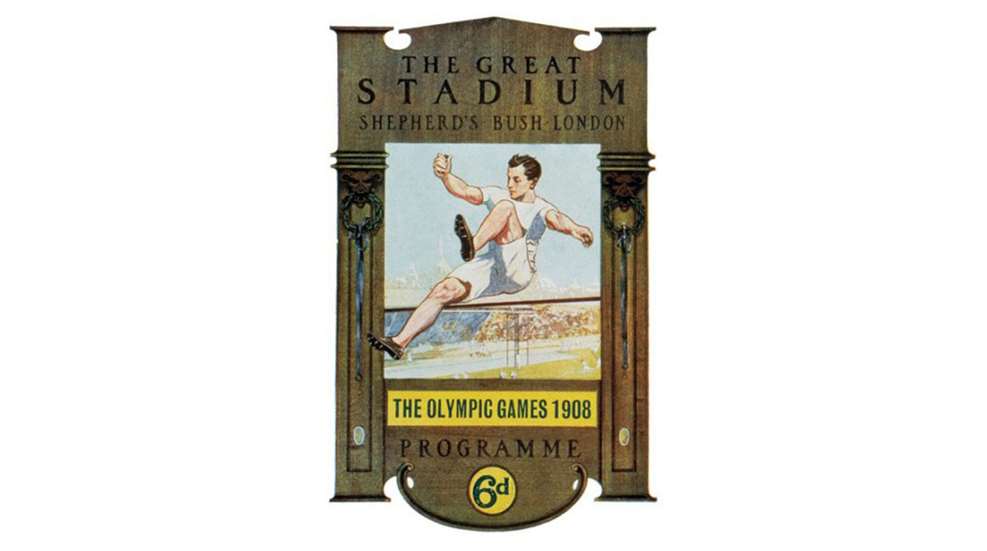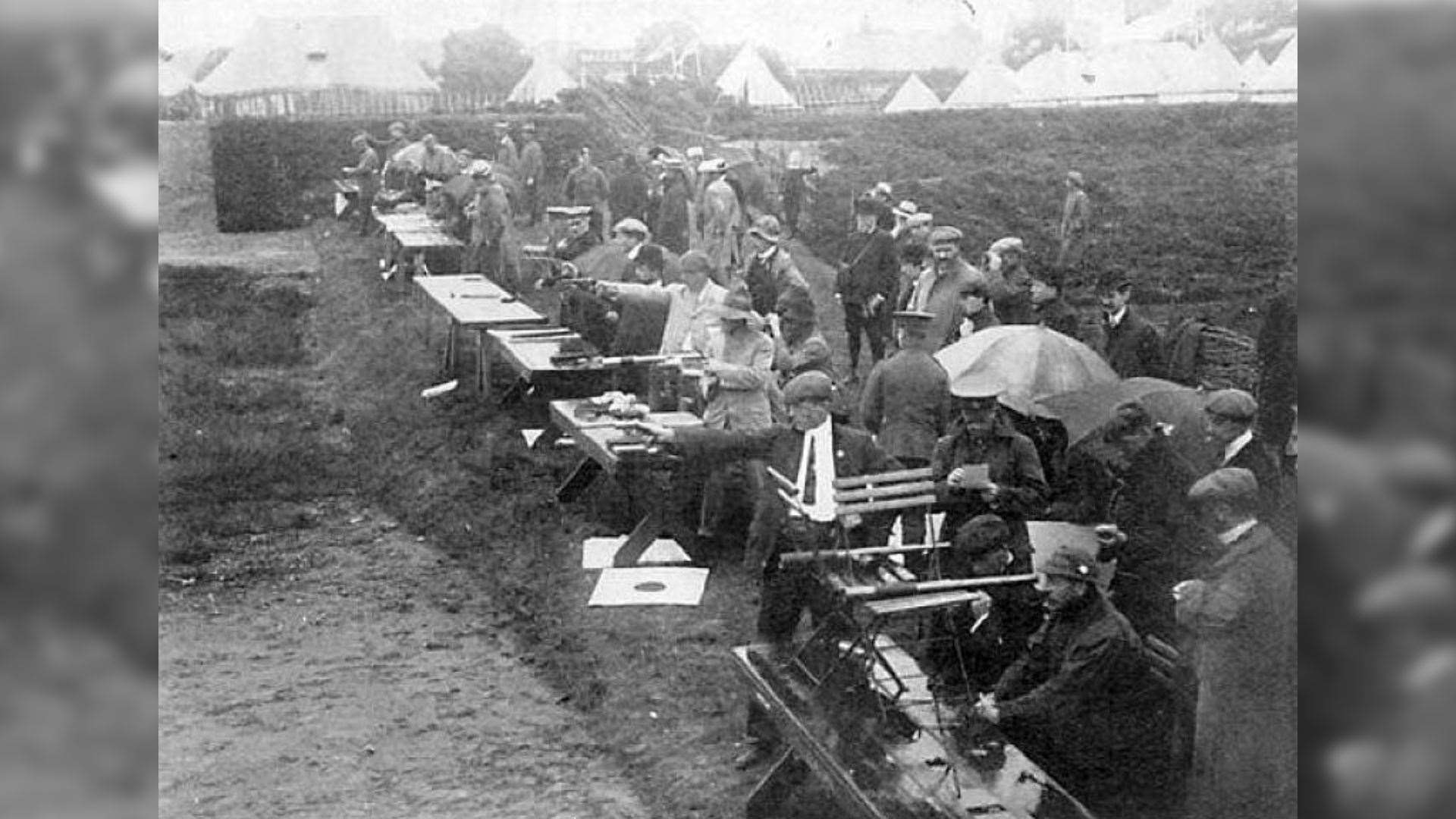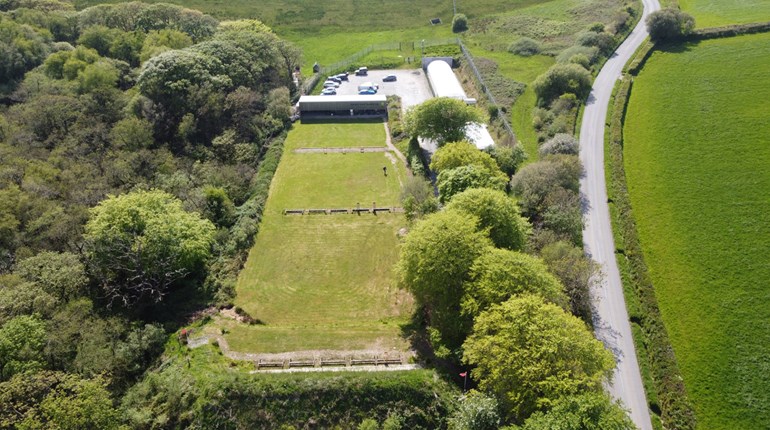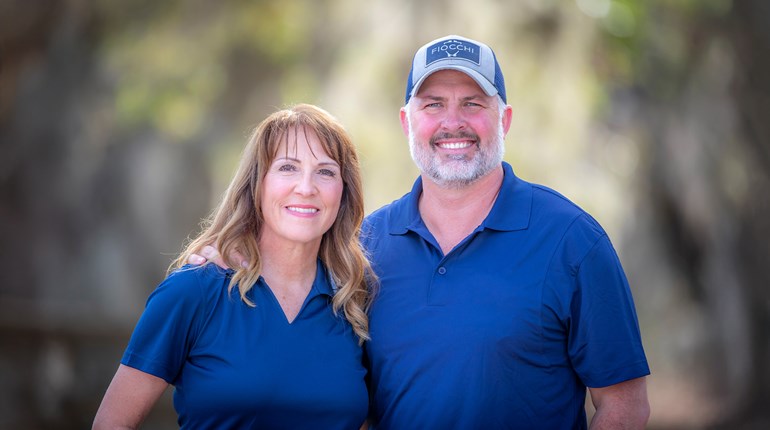
The below is an excerpt from the 1978 book, Olympic Shooting, written by Col. Jim Crossman and published by the NRA.
1908—London: The U.S. Team Almost Missed The Games
By Colonel Jim Crossman
The regular booming of a 35-gun salute punctuated the bellowing of steam whistles and the shrieking of sirens in New York harbor that glorious Saturday. The American liner New York was saluted by all passing ships and was surrounded by smaller boats flying full bunting. The U.S. revenue cutter Mohawk focused attention on the subject of the demonstration when she broke out the signal flags "ZBH UXX" as she fired the 35-gun salute.
A 35-gun salute? The President rates only 21 guns, so what was this that got the 35 guns? The answer to that is really the ending of the Olympic year of 1908—the year that almost wasn't.
When the National Rifle Association of America received the invitation from Britain to shoot in the 1908 Olympics, after due consideration it was decided that organizing, training and financing a team was too much of a problem. Public announcement was made of the decision not to send a team and the matter was considered a closed issue.
Consequently, there was great surprise and joy in the NRA offices when General James Drain, President, received an unusual letter from the United States Cartridge Company. Signed by C.W. Dimick, who headed the firm, the letter said in essence: We think the United States has the riflemen, the rifles and the ammunition to win. We think it would be a pity if the United States did not send a rifle team to the Olympics. We feel so strongly that the United States Cartridge Company will underwrite the expenses of a team.
Almost momentarily stunned by the magnificent offer, the NRA officials quickly recovered and accepted it—only to run into complaints from other ammunition makers that they had not been invited to participate.
As it finally worked out, the NRA opened a public subscription to gather funds for the team. The E.I. du Pont de Nemours Powder Company contributed $1,000 to the fund and the three main ammunition makers—United States Cartridge Company, Union Metallic Cartridge Company and Winchester Repeating Arms Company—agreed to split the remaining team expenses among themselves.
With the financial hurdle out of the way, it was high time to have a careful look at the program to see what would be needed in the way of shooters and equipment. The British Olympic Association, after being awarded the 1908 Games, had asked the National Rifle Association of Great Britain and Ireland to prepare a suitable program of rifle and pistol matches. In these early days of the Olympics, it was the prerogative of the host country to pick the shooting program. The British did go so far as to consult other countries regarding the program they would recommend. The comments were considered in planning a program that would show the types of shooting sponsored by the British shooting associations.

After considerable deliberation, the National Rifle Association of Great Britain arranged the following elaborate program:
Rifle Shooting
- The International Match, teams of six, service rifles—200, 500, 600, 800, 900 and 1,000 yards.
- Individual competition, match rifles—1,000 yards.
- Teams of six, any rifle—300 meters.
- Individual competition—300 meters.
Miniature Rifle Shooting
- Teams of four, miniature rifles—50 and 100 yards.
- Individual competition—50 and 100 yards.
- Individual competition, disappearing target—25 yards.
- Individual competition, moving target—25 yards.
Revolver and Pistol Shooting
- Teams of four, revolver or pistol—50 yards.
- Individual competition—50 yards.
Running Deer Shooting
- Teams of four, single, double or repeating rifle—110 yards.
- Individual competition—110 yards.
- Individual competition, double shot—110 yards.
In addition, the Clay Bird Shooting Association planned a 3-stage individual event and a similar 3-stage team event. Between the rifle, pistol and shotgun events, there was ample shooting for everyone.
While the National Rifle Association of America conducted the tryouts for the rifle shooters, the United States Revolver Association picked the 6-man handgun team. But unfortunately the United States did not send any shotgun shooters.
The riflemen decided that the International Match was by far the most important and this was the match to win.
The riflemen decided that the International Match—that grueling team event at six ranges—was by far the most important and this was the match to win. As a by-product, anything done for this should help win the 1,000-yard individual match. The other rifle events were pretty well ignored and, in fact, the U.S. did not enter most of them.
With the rifleman's goal—the International Match—clearly in mind, the next step was to get the best possible equipment. The conditions of this match called for the service rifle of the country with regulation sights, but permitted any safe ammunition. The United States service rifle was the relatively new 1903 Springfield. While shooters had some experience with this rifle, they had much less experience with the new 1906 service cartridge and its light, sharp-pointed, high-velocity bullet.
The Springfield rifles selected for the team were the best possible. Stocks and barrels were carefully chosen and the barrels were star-gauged and especially calibrated. The logical choice to work with the people at Springfield Armory in assembling the best possible rifles was K.K.V. Casey—one of the outstanding riflemen of the time. A member of the U.S. Palma Teams of 1902, 1903, 1907, 1912 and 1913, and he was team captain in 1923. In addition to shooting his way onto the 1908 Olympic team, he won the Wimbledon Cup in 1902, 1907 and 1908, as well as the Leech Cup in 1908. Casey was without a peer as a long-range shot and coach.
The problem of selecting the best ammunition was somewhat more difficult. Each ammunition maker was capable of making fine match cartridges. Each ammunition maker was jealous of his reputation and most anxious to have his ammunition chosen for use by the team. Although no strings were put on the offer of funds at the time United States Cartridge Company was the only firm in the act, it would have been logical to pick their ammunition. But with Winchester and UMC sharing the financing of the team, the only solution was to have an open competition. Ammunition was tested at ranges of 200, 600 and 1,000 yards and fired in strings of 17 shots to simulate the Olympic match conditions. The only measurement to be considered was the mean vertical deviation. This measurement gave an average vertical accuracy figure. It was obtained by drawing a horizontal line through the center-of-impact of the group of shots. The vertical distance to each shot was measured and the total divided by the number of shots.
The test was conducted on the Congress Heights Range, just outside Washington, D.C., on four days in early June. Winchester entered a cartridge with a 190-grain bullet. UMC submitted a 180-grain (Thomas) bullet and a 220-grain (Hudson) bullet, while U.S. Cartridge also entered two bullets, weighing 150 grains and 180 grains. All cartridges were loaded with NG-S2 powder. This was a modified Whistler and Aspinwall powder, with reduced nitroglycerine content. Although rather erosive, it was quite accurate and was preferred for competition. The long popular HiVel #2 was descended from NG-S2. During the test, the government's Frankford Arsenal submitted some special handloaded ammunition using Pyro powder. It can be easily seen that there were no restrictions put on the ammunition design—merely to produce the best stuff possible.
Since everyone was using cupro-nickel bullet jackets, the accepted material at the time, there was much trouble with metal fouling. Bullet jacket material would stick on the rifling and would gradually build up so much as to destroy accuracy. Consequently, much of the time was taken up cleaning, or doping, the barrels. A solution of ammonium persulfate and ammonium carbonate in ammonia water was poured into the barrel and usually dissolved the fouling within 15 minutes. While this cleaning process was highly annoying, it was one of the accepted penalties for shooting high-velocity, metal-jacketed bullets.
Since the United States Cartridge Company had offered to pay all the expenses of the rifle team, you might have a secret hope that their ammunition would turn out best. For once, justice triumphed! By the end of the fourth day of the test everyone agreed that the USC ammunition had not only taken first place, but second place as well.
Shooting was done from new, specially selected Springfield rifles mounted in a machine rest. While some 10-shot strings were fired at 200 yards as rapidly as possible, most of the shooting was in 17-shot strings with intervals between shots of 40 seconds at first, later increased to 60 seconds. With the exception of a few strings, both the USC entries shot better than their competitors. The USC 180-grain bullet had a considerable edge on its 150-grain companion at the 1,000-yard range and was the one finally selected.
The winning ammunition with its 180-grain bullet at 2,550 f.p.s. gave an average mean vertical deviation of 0.99 inches at 200 yards, 2.81 inches at 600, and 5.29 inches at 1,000 yards. Half the groups at short range and all the groups at 600 and 1,000 yards contained 17 shots. These figures mean that at 1,000 yards, for example, the bullet holes of the various 17-shot groups averaged only 5.29 inches above or below the center-of-impact. This was fine accuracy for that new .30-06 cartridge, and is comparable to accuracy of match ammunition of today.
Meanwhile, plans had gone ahead for the team tryouts. It was decided that they would be held on June 10, 11 and 12 and would be open to all citizens. Ohio offered the use of their fine state range at Camp Perry—to this day a mecca of all rifle and pistol shooters.
The tryouts consisted of shooting twice over the long, multi-range course of the proposed team match, the International.
The old-timers were not immune to mistakes and occasionally made the same mistakes fancied by shooters today. One of the great shots of the time, Jack Hessian, went into the very last stage of fire on the last day of the tryouts well up in fifth place. But Hessian put a bullseye on the wrong target, which was scored a miss and put him down into 10th place and almost off the team. The final results showed the team to be composed of:
- Cpl. Ivan L. Eastman, 2nd Ohio Infantry
- Sgt. William F. Leushner, 74th New York Infantry
- Lt. Harry E. Simon, 6th Ohio Infantry
- Capt. K.K.V. Casey, 1st Delaware Infantry
- Capt. Charles S. Benedict, 7th Ohio Infantry
- Maj. William B. Martin, 2nd New Jersey Infantry
- Sgt. Charles J. Jeffers, 8th Massachusetts Infantry
- Maj. Charles B. Winder, Ohio National Guard
- Lt. Edward A. Greene, U.S. Marine Corps
- Mr. John W. Hessian, Wilmington, Del.
The National Rifle Association had appointed Captain Frank E. Evans as Adjutant and General James A. Drain as Team Captain.
It was highly fitting that Drain should be so honored. For years he had been involved in promoting the National Rifle Association and shooting. Although only 34 at the time, he had been made the Adjutant General of the State of Washington. He was active in legislative affairs and had a host of friends. He helped prepare and guide legislation in 1903 which gave the NRA official recognition as the spokesman for shooters.
James A. Drain provided the forward thinking and aggressive leadership needed so badly at the time.
Moving to the East in 1904, he bought the popular outdoor magazine Shooting and Fishing and renamed it Arms and the Man. In 1916 he decided to retire from the publishing business and sold the magazine to the NRA for $1. An officer of the NRA for many years, Drain was president for four years (until 1910) and provided the forward thinking and aggressive leadership needed so badly at the time.
Plans were made for the tryouts to be shot and the ammunition test run June 10 to 12. The British Olympic Council demanded that the names of the team members be provided by June 1. This was manifestly impossible and the British were told the United States could not comply with this requirement. Instead, the names of all those who had made entry for the tryouts were cabled to England.
Everyone heaved a sigh of relief when the British cabled back that this would be all right. But consternation arose again at the next part of the cablegram, which required that the official entry blank, signed by the individual concerned, be submitted by June 1. With competitors coming from all over the country, once again officials had to tell the British they could not comply with their requirement. Instead, officials told the British the entries would be mailed promptly at the conclusion of the tryouts on June 13.
With the team sailing date of June 20 rapidly getting closer, things looked bleaker and bleaker. Negotiations were failing to get the British to change their minds and accept the U.S. entries. Finally on the morning of June 17, General Drain received word from England that the case was hopeless. With a heavy heart, he cancelled the steamship reservations and sent telegrams to the team members, telling them that despite all their work and effort, the team would not go.
But that afternoon Drain received word that the British would—repeat would—accept the American entries. The telephone and telegraph got another workout trying to get hold of the team. To everyone's surprise and pleasure, when the SS St. Louis backed out into the stream on June 20, all the team members were safely on board, complete with ammunition and equipment. After an unbelievable array of handicaps, the U.S. rifle team was finally on its way.
A little further up the New York harbor, the Umbria sailed at the same time, carrying the members of the United States pistol team. Although the U.S. Revolver Association had the difficult tasks of raising money for the team by public subscription and conducting tryouts for the team, these tasks seemed like child's play compared to the trials and tribulations of the NRA in getting the rifle team on the way.
As a result of preliminary tryouts, the 10 high pistol shooters were invited to a final two-day match at Sea Girt, N.J., to pick the six men to go to England. Most of the shooters were from the East, which as the center of pistol shooting, but J.E. Gorman made the five-day trip from San Francisco arriving just as the finals started.
Everyone shot a .22 single-shot pistol except Gorman, who used a revolver and ammunition loaded with black powder on the first day. At the end of that day, his .22 pistol arrived and, after considerable gunsmithing to make it usable, he shot it the rest of the time, with improving scores.
As a result of the preliminary and final tryouts, the United States Revolver Association picked six men to make the journey to England. The elected team captain was Dr. Reginald H. Sayre, a very fine shot, at that time president of the United States Revolver Association and formerly treasurer of the NRA. Other team members from New York were T. Le Boutillier and J.A. Dietz. Springfield, Mass., was the center of much pistol activity, and C.S. Axtell and Dr. I.R. Calkins proved to be the best. The lone Westerner was J.E. Gorman of San Francisco. The team was to be joined in England by Walter Winans, one of the outstanding, spectacular shooters of the day.
There was some considerable question as to Winans' eligibility. Born in Russia, he was an American who had spent most of his life in England. An ardent outdoorsman and hunter, he had many talents, including writing and art. His books, classics of their time, included The Sporting Rifle, The Art of Revolver Shooting, Hints on Revolver Shooting and Practical Rifle Shooting and contained many sketches and illustrations by Winans. Holder of innumerable records with rifle, pistol and shotgun, he was active in shooting up to the time of his death in 1920.
Since Winans had been out of this country so long, most people thought of him as English. By 1908, he had held the handgun championship of England for 12 years. In order to clear up this matter and to insure his eligibility for the 1908 U.S. team, he swore his allegiance to the United States to the Consul General and expressed his intention to return to the United States to resume the duties of his citizenship.
Read Part 2, and be sure to check out this article on the Athens 1906 Olympics.
See more: Open To Civilians: The 1904 National Championships

































